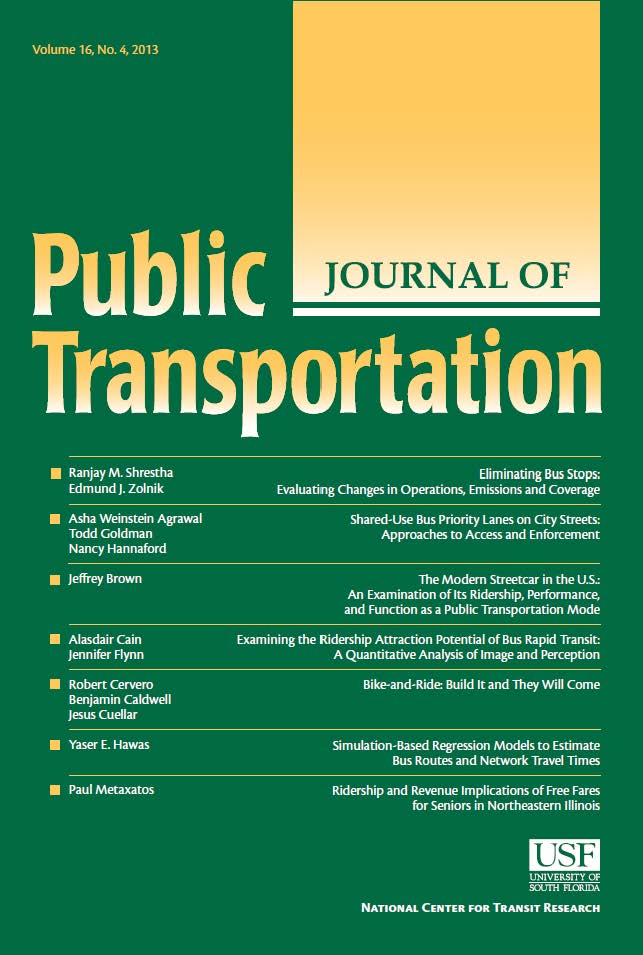评估乘客群体对公共交通拥挤的影响
IF 2
4区 工程技术
Q3 TRANSPORTATION
引用次数: 0
摘要
公共交通的车内拥挤对乘客的旅行体验有很大影响。然而,人们对不同乘客群体如何造成车内拥挤却知之甚少。对特定乘客群体对系统影响的经验性了解有助于更有效地调整政策工具,如新的票价结构、专门的公共交通服务、基础设施投资和运力供应。我们提出了一种方法,通过智能卡数据分析来捕捉特定乘客群体对拥挤的贡献。我们提出了两个乘客行程层面的拥挤贡献指标:(1) 对载客率的时间加权贡献和 (2) 对载客率的最大贡献。我们将提出的方法应用于瑞典斯德哥尔摩地区的多式联运公共交通系统。我们为两类人群演示了该方法:在校学生和穿越斯德哥尔摩内城的乘客。我们的研究结果表明,学生和穿越内城的乘客对拥挤的贡献率相似,在上午和下午的高峰时段,他们分别占用了所有交通工具座位数的 15% 和 11%。通勤铁路网及其周边的一些地区,在上午高峰时段,学生和穿越内城的乘客对其座位容量的利用率平均分别超过 70% 和 90%。本文章由计算机程序翻译,如有差异,请以英文原文为准。
Assessing contributions of passenger groups to public transportation crowding
On-board crowding in public transportation has a significant impact on passengers' travel experience. However, there is little knowledge of how different passenger groups contribute to on-board crowding. Empirical knowledge of specific passenger groups' impact on the system facilitates more effective tuning of policy instruments such as new fare structures, dedicated public transportation services, infrastructure investments, and capacity provision. We propose a method to capture the crowding contributions from selected passenger groups by means of smart card data analytics. Two crowding contribution metrics at the passenger journey level are proposed: (1) time-weighted contribution to load factor and (2) maximum contribution to load factor. We apply the proposed method to the multimodal public transportation system of Region Stockholm, Sweden. We demonstrate the method for two groups: school students, and passengers traversing Stockholm's inner city. Our findings indicate that school students and passengers traversing the inner city have similar crowding contributions, utilizing 15 % and 11 % of the seating capacity across all modes during the AM and the PM peak, respectively. The commuter rail network, as well as some of the areas neighboring it, experience on average more than 70 % and 90 % utilization of their seating capacity during the AM peak, by school students and passengers traversing the inner city, respectively.
求助全文
通过发布文献求助,成功后即可免费获取论文全文。
去求助
来源期刊

Journal of Public Transportation
TRANSPORTATION-
CiteScore
6.40
自引率
0.00%
发文量
29
审稿时长
26 days
期刊介绍:
The Journal of Public Transportation, affiliated with the Center for Urban Transportation Research, is an international peer-reviewed open access journal focused on various forms of public transportation. It publishes original research from diverse academic disciplines, including engineering, economics, planning, and policy, emphasizing innovative solutions to transportation challenges. Content covers mobility services available to the general public, such as line-based services and shared fleets, offering insights beneficial to passengers, agencies, service providers, and communities.
 求助内容:
求助内容: 应助结果提醒方式:
应助结果提醒方式:


